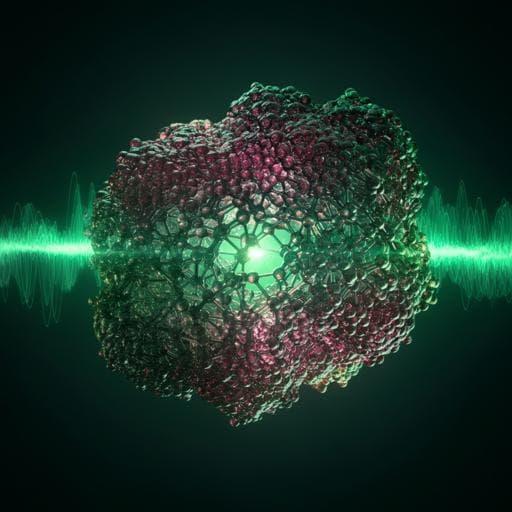
Physics
Quantum simulation of an extended Dicke model with a magnetic solid
N. M. Peraca, X. Li, et al.
Explore groundbreaking research on an extended Dicke model simulated with a crystal of ErFeO3, revealing novel atomically ordered phases and critical phase transitions. This exciting study, led by a team of talented authors, paves the way for new insights into multiatomic quantum optics in solid-state systems.
~3 min • Beginner • English
Introduction
The Dicke model in quantum optics describes cooperative, coherent coupling between an ensemble of two-level atoms and a single-mode light field and hosts a superradiant phase transition (SRPT) when the light-matter coupling g exceeds a threshold, yielding a many-body ground state with emergent atomic and photonic polarizations. While the original model assumes noninteracting atoms, atom-atom interactions are known to be important, motivating an extended Dicke model (the g–J model) that includes both photonic-field-mediated long-range interactions and direct short-range interatomic interactions of strength J. The ground state is expected to depend critically on g/J, favoring a superradiant phase for large g/J and an atomically ordered phase for small g/J, but analytic solutions are generally unavailable, prompting quantum simulation efforts. Prior computational studies predicted rich phenomena including first-order quantum phase transitions, shifts of the SRPT boundary, modified entanglement, and altered excited-state QPTs, and experimental platforms have been proposed but not realized. Here, the authors introduce erbium orthoferrite (ErFeO3), an antiferromagnetic insulator, as a solid-state simulator of the g–J model. In this analogy, Er3+ spins play the role of atoms and Fe3+ magnons the photonic field; prior work showed Dicke cooperativity in Er–Fe interactions, and a low-temperature magnetic phase transition in ErFeO3 mirrors a Dicke SRPT: below ~4 K the Er lattice develops C-type AFM order and a zone-boundary Fe3+ magnon condenses, corresponding to emergent atomic and photon polarizations. Mean-field modeling indicates simultaneous order parameter onsets for Er3+ and Fe3+ spin components, mapping Γ2 (normal) to Γ12 (superradiant) phases. This work aims to experimentally realize and map the extended Dicke model’s phases and phase boundaries in temperature–magnetic-field space, including the predicted atomic phase driven by interatomic interactions.
Literature Review
Computational studies of the extended Dicke (g–J) model under various approximations have predicted: (i) first-order quantum phase transitions and discontinuous behavior (e.g., Lee & Johnson 2004; Zhao et al. 2017), (ii) shifts in the SRPT boundary due to interatomic interactions, (iii) enhanced integrability-to-chaos transitions and quantum chaos signatures, (iv) modifications to matter–matter entanglement and ground-state structure, and (v) changes in the character of excited-state QPTs. Proposed experimental simulators include atomic Bose–Einstein condensates, superconducting qubit arrays in circuit QED, and quantum dots, but successful experimental simulation of the g–J model remained elusive. In rare-earth orthoferrites and orthochromites, spin reorientation transitions and coupled spin–crystal-field dynamics have been studied, with evidence of Dicke-like cooperativity in ErFeO3 and magnonic SRPT signatures discussed in related compounds (YbFeO3, TbFeO3). However, establishing a concrete mapping to an extended Dicke Hamiltonian and demonstrating distinct phase boundaries (including first-order) within a single solid-state platform had not been achieved prior to this work.
Methodology
Theory and modeling: The magnetic system of ErFeO3, comprising Er3+ and Fe3+ spins and their interactions, is described by a microscopic spin Hamiltonian including Fe–Fe interactions (exchange, Dzyaloshinskii–Moriya, anisotropies), Er–Er exchange, and Fe–Er interactions. Mean-field treatment with a two-sublattice approximation (A/B) is employed, yielding equations of motion for Er and Fe spins. Equilibrium spin configurations are found self-consistently via mean fields and partition functions (Er: two-level Kramers doublet; Fe: Brillouin function), and phase diagrams are obtained by minimizing free energy. The Hamiltonian is second-quantized to map onto an extended Dicke form with Fe3+ magnons as bosons and Er3+ spins as two-level atoms. The simplified Dicke-like Hamiltonian includes: Fe magnon mode with frequency ωa, Er spin frequency, Zeeman term with ωZ = gμBμ0H/ħ for H∥z, Er–magnon coupling g (long-range), and Er–Er short-range coupling J. Dominant coupling terms are retained (JFe–Er dominant), and relevant Er operators (Σx, Σz) for the low-T transition are considered, leading to an effective g–J model (Eq. (1)) with material parameters J = 0.037 meV, g = 0.48 meV, ω1/2π ≈ 0.896 THz, ωc2/2π ≈ 0.023 THz. Zeeman tuning with H∥z controls Σz and tips the balance between g and J to induce S→A transitions. Mean-field phase diagrams in T–H space and order parameter evolutions across S→A (first order) and A→N (second order) boundaries are computed.
Experimental setup: Single-crystal ErFeO3 was grown via optical floating-zone method after solid-state synthesis of polycrystalline feed rods. THz time-domain transmission magnetospectroscopy in the Faraday geometry was performed from 1.4–300 K and μ0H up to 10 T using an Oxford Spectromag-10T cryostat; THz pulses were generated by optical rectification (Ti:sapphire, 775 nm, 150 fs, 1 kHz) and detected by electro-optic sampling in ZnTe. Absorption coefficient spectra α(ω) were extracted from the complex refractive index via standard TDS analysis using Fresnel coefficients and propagation phases, assuming well-separated Fabry–Pérot echoes; modulus and phase of the transfer function H(ω) yield n(ω), κ(ω), and α(ω). Magnetization measurements (iso-field and isothermal) were used to locate S→A and S→N boundaries, with attention to demagnetization effects from a thin disk-shaped sample. Magnetocaloric effect (MCE) measurements in a quasi-adiabatic configuration (PPMS) mapped the T–H phase diagram by recording T(H) at a field sweep rate 5×10−3 T s−1 with temperature sensitivity ≈5×10−6 K; transition fields were identified from extrema in dT/d(H), corresponding to steps in (∂S/∂H)T.
Data interpretation: The Fe3+ quasi-antiferromagnetic (qAFM) magnon mode frequency serves as an order parameter (OP) proxy for the superradiant (S) phase; a kink/shift indicates OP onset, while its absence signals no Fe OP in the atomic (A) phase. THz spectra versus H and T were used to distinguish qAFM modes from the quasi-ferromagnetic (qFM) mode and to observe coexistence of S and A phase modes across first-order boundaries. MCE extrema and THz-defined mode behaviors were overlaid to construct the experimental T–H phase diagram and to classify transition orders.
Key Findings
- Solid-state quantum simulation of an extended Dicke (g–J) model realized in ErFeO3, mapping Er3+ spins to atoms and Fe3+ magnons to the bosonic field.
- Identification of three phases: normal (N), superradiant (S), and a distinct atomic (A) phase driven by short-range Er–Er interactions (J-term), which lacks Fe3+ magnon order.
- Mean-field T–H phase diagram (H∥z) predicts and experiments confirm: (i) S→A transition at low T induced by magnetic field, (ii) A→N transition at higher fields/temperatures, and (iii) a triple point where S, A, and N meet near T ≈ 2.8 K and μ0H ≈ 0.5 T.
- Transition orders: S→A is first-order (abrupt OP change, coexistence of modes), A→N is second-order (continuous), and N↔S at higher T (near 4 K at H≈0) is second-order.
- THz spectroscopy: At 0 T, the Fe3+ qAFM mode shows a kink/OP-like onset below ≈4 K, marking N→S. At 1.4 K versus H, distinct qAFM lines appear for S and for A/N phases, with coexistence between ≈0.5 T and ≈1 T indicating first-order S→A; the S-phase qAFM line around 0.8 THz at 0 T transitions to an A/N-phase line near 1 THz at 0.5 T. At 3.2 K, the S-phase qAFM mode (≈0.88 THz at 0 T) connects continuously to the N-phase frequency with field, consistent with a second-order boundary; at 4.4 K only N-phase behavior persists across H.
- Constant-field THz maps confirm: at 0 T, a continuous OP-like qAFM shift below 4 K (N→S); at 0.75 T, an N→A transition shows no OP-like anomaly in the qAFM frequency (no Fe OP in A); at 1.25 T the N phase persists across T without anomalies.
- Magnetocaloric effect (MCE): dT/d(H) traces show two maxima for T < 2.8 K (S→A and A→N) and one maximum for 2.8 K < T < 4 K (S→N), enabling mapping of phase boundaries; measurement parameters: quasi-adiabatic, sweep rate 5×10−3 T/s, temperature sensitivity ~5×10−6 K.
- Magnetization: Clear S→A and S→N boundaries observed; A→N weak due to demagnetization broadening in a disk-shaped sample.
- Theoretical control knob: Zeeman term enhances |⟨Σz⟩|, rebalancing g vs J because Σz appears only in the J-term, enabling field-driven S→A transition. Critical fields for S→A at low T are ~0.35–0.5 T, increasing with T.
- Model parameters (effective): g ≈ 0.48 meV, J ≈ 0.037 meV; dominant Fe–Er coupling retained in the effective Hamiltonian.
Discussion
The study addresses whether a well-characterized magnetic solid can simulate the extended Dicke (g–J) model, including realizing an atomic phase and revealing the nature of phase transitions. By mapping ErFeO3’s spin system onto an extended Dicke Hamiltonian and using magnetic field as a nonthermal tuning parameter, the experiments demonstrate the predicted interplay between long-range, field-mediated coupling (g) and short-range interatomic coupling (J). The observation of a distinct atomic (A) phase—characterized by Er3+ antiferromagnetic order with no Fe3+ magnon order—confirms behavior beyond the standard Dicke model. The identification of transition orders (first-order S→A with phase coexistence and second-order A→N and N↔S) provides direct experimental evidence for phenomena anticipated in theoretical studies of the g–J model. The T–H phase diagram, including a triple point near 2.8 K and 0.5 T, establishes comprehensive control over phases and boundaries. Importantly, THz magnetospectroscopy disentangles Fe3+ magnon order parameters from Er3+ spin order, clarifying the photonic vs atomic sector behavior. The platform’s tunability and clear phase signatures suggest broader applicability to quantum optics models and many-body physics. The authors discuss potential extensions to other orthoferrites/orthochromites (e.g., YbFeO3 for nearly pure g-model behavior and TbFeO3 for Jahn–Teller-type transitions) and outline advantages of the low-temperature transition in ErFeO3 (presence of first-order A phase, two-level Kramers doublet basis, negligible thermal magnons) over higher-temperature spin reorientation transitions. These findings bridge quantum optics and condensed-matter many-body physics and point to applications in engineered hybrid models (Dicke–Ising, Dicke–LMG), studies of unconventional quantum criticality, and chaos-assisted thermalization.
Conclusion
Through THz magnetospectroscopy, magnetocaloric effect, and magnetization measurements, the authors realize a solid-state quantum simulation of the extended Dicke (g–J) model in ErFeO3. Beyond the normal and superradiant phases of the standard Dicke model, they identify an atomic phase driven by short-range Er–Er interactions and determine the orders of the phase boundaries: first-order S→A and second-order A→N and N↔S. The experimentally mapped T–H phase diagram, including a triple point, validates theoretical predictions and demonstrates field-controlled navigation between phases. This magnetic-solid platform enables exploration of multiatomic quantum optics models with high controllability, offering routes to probe quantum chaos, entanglement modification, and hybrid Dicke-based Hamiltonians. The ability to traverse superradiant and atomic phases via a nonthermal tuning knob opens opportunities to investigate unconventional quantum criticality and thermalization phenomena.
Limitations
- Demagnetization effects from the thin, irregular disk-shaped sample used for magnetization broadened phase boundaries and obscured a clear A→N signature in magnetization, though MCE and THz data compensated for this limitation.
- Mean-field and two-sublattice approximations may neglect fluctuations, domain effects, and spatial inhomogeneities, potentially affecting precise critical parameters and transition sharpness.
- In constructing the effective extended Dicke Hamiltonian, only the dominant Fe–Er coupling term was retained while other coupling terms were neglected, which may introduce quantitative deviations.
- Zeeman tuning and sample geometry can shift apparent transition fields in MCE due to demagnetization; quantitative boundary positions may differ from ideal values.
- The identification of phase coexistence and transition orders relies on spectroscopic signatures and dT/d(H) extrema; finite domain distributions and inhomogeneities could influence observed coexistence ranges.
Related Publications
Explore these studies to deepen your understanding of the subject.







